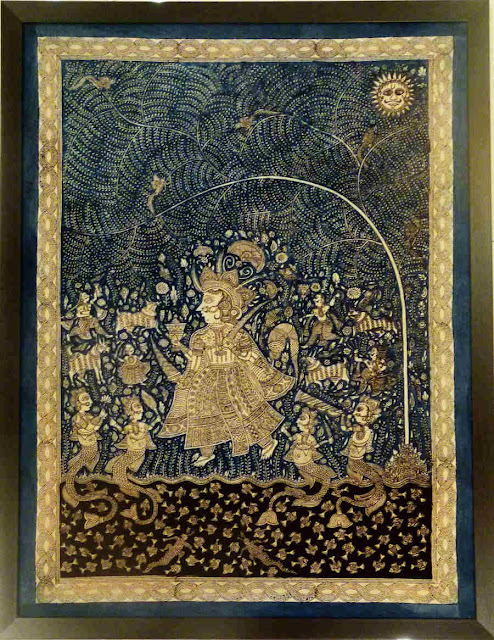Mata Ni Pachedi; The Sacred Art Of Gujarat
With the celebrations of Navratri just concluded, and today being the tithi of Poonam, every house is chanting songs at the Mata Ki Chowki celebrations today. While the decoration for the Mata ki Chowki is just like any other celebration, one thing that takes centre stage is the Mata ni Pachedi. Literally translated as 'behind the mother goddess', Mata ni Pachedi is a natural pure cloth that constitutes a temple of the Mother Goddess.
Traditionally, red is the main colour of the paintings, the mother goddess dominates the painting with stories laden with numerous characters and motifs in the background. In Gujarat, artisans make these paintings using the same methods used traditionally, using natural colours and dyes.
Mata ni Pachedi is also known as the “Kalamkari of Gujarat”, owing to its similarity with the Kalamkari practised in Southern India and the use of pens (kalam) fashioned out of bamboo sticks, for painting. The Process is, a cotton fabric is first de-starched and then treated with Harada paste, to prepare it for absorbing the colour. Outlines of the figures are painted first. After this, red colour extracted from tamarind seeds, is filled in and the areas supposed to be white are left blank. After application of each colour, the fabric is boiled to bring out the colour and then washed in Sabarmati River. The cloth must be washed in running water only, so that any excess colour flows away, instead of staining the cloth. This is also a way to purify the painting.
While craftsmen are refining this folk craft to suit the changing times, yet the sanctity of this religious artefact remains untouched. Creating Pachedis as well as new illustrations that are relevant in today’s context, but in the same folk style, these craftsmen have remained true to the cause of spreading the glory of the Mother Goddess and her wonderful art.
In the olden days when the nomadic Vaghari community of Gujarat was barred from entering temples and other religious places, they made their own shrines with depictions of the Goddess on a piece of cloth. This ingenious solution is believed to be the origin of Mata ni Pachedi, the sacred art.
Traditionally, red is the main colour of the paintings, the mother goddess dominates the painting with stories laden with numerous characters and motifs in the background. In Gujarat, artisans make these paintings using the same methods used traditionally, using natural colours and dyes.
Mata ni Pachedi is also known as the “Kalamkari of Gujarat”, owing to its similarity with the Kalamkari practised in Southern India and the use of pens (kalam) fashioned out of bamboo sticks, for painting. The Process is, a cotton fabric is first de-starched and then treated with Harada paste, to prepare it for absorbing the colour. Outlines of the figures are painted first. After this, red colour extracted from tamarind seeds, is filled in and the areas supposed to be white are left blank. After application of each colour, the fabric is boiled to bring out the colour and then washed in Sabarmati River. The cloth must be washed in running water only, so that any excess colour flows away, instead of staining the cloth. This is also a way to purify the painting.
While craftsmen are refining this folk craft to suit the changing times, yet the sanctity of this religious artefact remains untouched. Creating Pachedis as well as new illustrations that are relevant in today’s context, but in the same folk style, these craftsmen have remained true to the cause of spreading the glory of the Mother Goddess and her wonderful art.
To know more about this traditional art form you could connect with Baaya Design, where tradition meets design through the website or via email.
Until next time,
~ Heena













0 comments